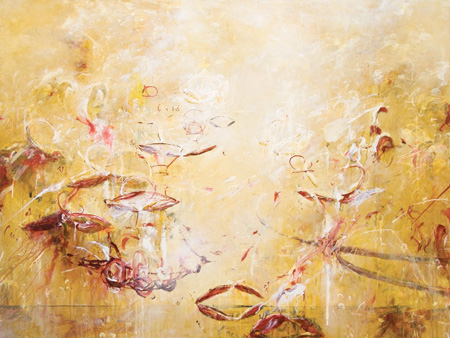
Growing up on a cattle ranch in Eastern Washington, Northwest painter Michael Schultheis had limited options. If he ever wanted to leave, a high school teacher told him, math could be his ticket out. It was a memorable instance of letting another person influence the path he'd take. He accepted a full scholarship to Washington State University, earned a masters degree from Cornell, and established a distinguished career as a mathematician and economist, all before finding his voice as a painter, and giving visual form to the ideas contained within higher mathematics.
It happened on State Route 520; Schultheis was listening to the NPR radio program "Fresh Air" while host Terry Gross was conducting an interview with an artist who asserted "painters should paint what they know." Crossing the Evergreen Point Floating Bridge, Schultheis ironically created a bridge of his own--he would join his knowledge of math to his passion for painting. He'd been painting since his student days at Cornell, mainly as a hobby to counter student stress, and concentrating on still-life paintings and landscapes. But there, amidst graduate lectures, were hints that math could be visual fodder as well. At Cornell, Schultheis studied under a Professor from New Delhi who wrote her equations using chalk and dry erasure. The result of constant writing and erasing, remembers Schultheis, was a ghostly trace of notations left on the chalkboard's surface. "Once she had completed writing the equation," remembers Schultheis, "she would look at it then say in her charming New Delhi accent, "Very very elegant." The equations in her mind formed a wonderful composition."
To construct his paintings, Schultheis begins by scrawling general ideasÑmostly mathematical notationsÑonto a blank white canvas. "They"re more like hunches," explains Schultheis, "thoughts from the periphery." Then, using a rag dipped in paint, he partially obscures his markings. His canvases are the result of multiple layers that include the theories of some of the world"s greatest thinkers such as Galileo and Leonardo da Vinci. To these Schultheis adds abstract concepts of his own, including geometric forms that have been re-visualized in the mind of the artist.
Schultheis' most recent show references Euclid, the father of geometry. Borrowing from the Greek mathematician's treatise on perspective that reveals, among other things, how the shapes of cylinders and cones change when viewed from different angles, Schultheis gives concrete form to a mathematician's mindscape. The transformation from notation, to geometric shape, and to the artist's personal rendering is exemplified in Coronation of Euclid 01, in which a Euclidian conic form has unexpectedly opened up; its sides splayed outward like unfurling petals. For all of Schultheis' interest in mathematic notions, the canvases themselves remain largely sensual, with fog-like swathes of white partially obscuring brightly colored squiggles that suggest marine life or the lively movement of water.
Each painting in the series of ten blue and white paintings titled Delft Optics 1-10 offers pared-down versions of Schultheis' larger canvases: signature traces of notations, partially obscured geometric shapes and those that have, through manipulation, become other forms entirely. But equations aside, his work also has a strong human component. The series is dedicated to a recently deceased friend, the first person to encourage Schultheis to paint. Schultheis' friend had collected Delftware, a pottery of Dutch origin that by the early 17th century was imported from China. Like Schultheis' work in the field of higher mathematics, Delftware has a long history of cultural give and take.
Ultimately, Schultheis' paintings are mathematics with a human face. "Mathematics, like aesthetics, can transfer from one culture to the next," explains Schultheis. "I'm profoundly interested in how things open up in my mind by changing Euclid's ratios. But also in how a single individual can have a profound impact on another."
"Michael Schultheis: Optics of Euclid" was on view from September 22 -- October 27, 2010, at Winston Wachter Fine Art, in Seattle, WA. www.winstonwachter.com
This article was written for and published in art ltd. magazine ![]()
